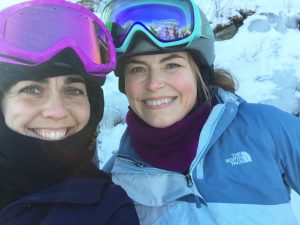By Erica Houskeeper
I started skiing back in the 1970s when I was a preschooler. For a long time, skiing was my favorite sport and winter my favorite season. Nearly every weekend between December and March, I would explore trails in the woods on my Fischer skis or barrel down beginner and intermediate terrain in southern Vermont.
At some point in my early teens, fear and intimidation set in on the slopes. Suddenly, skiing was not as much fun as it used to be as a young kid. I gave it up until returning to the sport sporadically in my 20s and 30s, then took a break again after becoming a mom at age 40. I never excelled at skiing the way I had once hoped.
Now I’m 45, and for the first time in many years I’m skiing every weekend. Still, my last ski lesson was in 1985, so my technique has never been refined as an adult. Also, over the past decade, the technology of skis and boots has changed for the better. But my ski style has been stuck in the past. Rather than taking advantage of my wider, shorter skis, I’ve been skiing like I’m still on my straight — and very long — K2 skis from 20 years ago.
Women on Snow at Stratton Mountain
Earlier this week, I attended the two-day Women on Snow ski camp at Stratton Mountain with the team from Ski Vermont’s All Mountain Mamas family travel ski blog, which sponsored the trip.

Courtesy of Stratton Mountain.
Led by female instructors and guest coaches, the Women on Snow group lesson camp is designed to build confidence in a supportive, fun environment. Whether you are a first-time skier, beginner, intermediate or expert, the Women on Snow clinic is an excellent program for all levels.
My instructor, Amy Macy, of Guilford, Conn., gave me important tips and reassurance as we skied together at Stratton. She also challenged me and encouraged me. We skied the advanced and expert trails like Black Bear, Drifter, and Upper Liftline. At times, we skied on one ski, without poles, and even with our hands on our hips.
For me, skiing with Amy was a gift. I have old school muscle memory and tend to ski tight with my legs too close together, not enough weight on my uphill ski, and my shoulders are uneven when I turn. With Amy’s guidance, I’ve finally made the step to become a much better, more advanced skier.
Here are a few things that I learned:

With fellow All Mountain Mamas blogger Gina Vercesi.
Keep an athletic stance.
The ideal way to stand on your skis is with your feet hip width apart, using your ankles, knees, and hips flexing and extending to stay balanced over your feet. Hold your hands slightly above hip level, and keep your shoulders parallel to the slope. Without it, you’ve got an unstable foundation that will crumble with any change in terrain or pitch.
Keep your skis apart.
When I was younger, the best skiers all had their skis really close together. These days, skis should be hip width apart. A hip width apart is the right distance because it makes both skis sit on the snow at the same angle, allowing you to carve a turn properly and efficiently. Amy pointed out that it’s OK to bring skis together at times when you’re changing things up a bit like in a skidded turn. But for the most part, keep them apart.
Keep your skis down in a turn rather than lifting.
I tend to lift my inside ski when I turn (very old school), and I found it difficult to stop doing that, especially when I got tired. But both skis need to be engaged when you turn – even though more weight will still be placed on the outside (downhill) ski.
Keep your head up and look down the mountain.

Amy giving us pointers.
Don’t look down at your skis when you’re skiing. Sounds obvious, but I didn’t realize I had a habit of staring down at the tips of my skis rather than looking up and keeping my eyes level. I need to remember to look down the hill. It is similar to riding a bike and staring at your front tire the whole time, which is not really safe and not good for balance.
Keep taking lessons.
I told Amy that I resisted lessons over the years because I felt somewhat intimidated by my limitations.
Here’s what she told me:
“Many skiers feel limited in their ability and are inhibited by their limitations. Some are intimidated by instruction, feeling they will spend too much time in their fear zone. Choose an instructor you feel comfortable with. At the start of the lesson, explain your inhibitions. Your lesson should be a learning partnership between you and your instructor. As instructors, we work to build trust in our students. We want our students to learn and enjoy the lesson. We want our students to come back and to be a lifelong learner and a lifelong skier.”
Sounds like a plan. See you at Stratton’s Women on Snow Program next year.
**If You Go: The Stratton Mountain Women on Snow Program is offered in December, January, February, and March. The program costs $ 379 and includes two full days on-snow instruction, food card (breakfast/lunch), demos from First Run Ski Shop and access into Stratton’s Training & Fitness Center. Lift tickets are not included.

Courtesy of Stratton Mountain.
This post written by Erica Houskeeper and originally appearing on her blog Happy Vermont.

